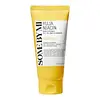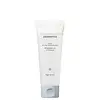What's inside
What's inside
 Key Ingredients
Key Ingredients

 Benefits
Benefits

 Concerns
Concerns

 Ingredients Side-by-side
Ingredients Side-by-side

Water
Skin ConditioningSodium C14-16 Olefin Sulfonate
CleansingCitrus Junos Fruit Extract 11%
Skin ConditioningCocamidopropyl Betaine
CleansingAcrylates Copolymer
1,2-Hexanediol
Skin ConditioningGluconolactone
Skin ConditioningTetradecene
EmollientSodium Chloride
MaskingGlycerin
HumectantHexadecene
SolventSaccharide Isomerate
HumectantCaprylyl Glycol
EmollientXanthan Gum
EmulsifyingSodium Citrate
BufferingCitric Acid
BufferingNiacinamide
SmoothingPropanediol
SolventSodium Hyaluronate
Humectant3-O-Ethyl Ascorbic Acid
Skin ConditioningSuccinic Acid
BufferingHydrolyzed Hyaluronic Acid
HumectantSodium Hyaluronate Crosspolymer
HumectantEriobotrya Japonica Leaf Extract
Skin ConditioningHydrogenated Lecithin
EmulsifyingHydrolyzed Glycosaminoglycans
HumectantPolyglyceryl-10 Stearate
Skin ConditioningPanthenol
Skin ConditioningMentha Viridis Extract
MaskingSodium Acetylated Hyaluronate
HumectantBenzyl Glycol
SolventSodium Ascorbyl Phosphate
AntioxidantEthylhexylglycerin
Skin ConditioningBiotin
AntiseborrhoeicPyridoxine
Skin ConditioningFolic Acid
Skin ConditioningHyaluronic Acid
HumectantRaspberry Ketone
MaskingTocopherol
AntioxidantCyanocobalamin
Skin ConditioningLinoleic Acid
CleansingThiamine Hcl
MaskingInositol
HumectantRiboflavin
Cosmetic ColorantBeta-Carotene
Skin ConditioningDisodium EDTA
Parfum
MaskingLimonene
PerfumingLinalool
PerfumingWater, Sodium C14-16 Olefin Sulfonate, Citrus Junos Fruit Extract 11%, Cocamidopropyl Betaine, Acrylates Copolymer, 1,2-Hexanediol, Gluconolactone, Tetradecene, Sodium Chloride, Glycerin, Hexadecene, Saccharide Isomerate, Caprylyl Glycol, Xanthan Gum, Sodium Citrate, Citric Acid, Niacinamide, Propanediol, Sodium Hyaluronate, 3-O-Ethyl Ascorbic Acid, Succinic Acid, Hydrolyzed Hyaluronic Acid, Sodium Hyaluronate Crosspolymer, Eriobotrya Japonica Leaf Extract, Hydrogenated Lecithin, Hydrolyzed Glycosaminoglycans, Polyglyceryl-10 Stearate, Panthenol, Mentha Viridis Extract, Sodium Acetylated Hyaluronate, Benzyl Glycol, Sodium Ascorbyl Phosphate, Ethylhexylglycerin, Biotin, Pyridoxine, Folic Acid, Hyaluronic Acid, Raspberry Ketone, Tocopherol, Cyanocobalamin, Linoleic Acid, Thiamine Hcl, Inositol, Riboflavin, Beta-Carotene, Disodium EDTA, Parfum, Limonene, Linalool
Aloe Barbadensis Leaf Extract
EmollientWater
Skin ConditioningSodium Methyl Oleoyl Taurate
CleansingLauryl Glucoside
CleansingGlycerin
HumectantSodium Chloride
MaskingPanthenol
Skin ConditioningSodium Olivate
CleansingChamaecyparis Obtusa Leaf Extract
Skin ConditioningRosa Rugosa Leaf Extract
HumectantCitric Acid
BufferingMelissa Officinalis Leaf Extract
Skin ConditioningSodium Sweetalmondamphoacetate
Cleansing1,2-Hexanediol
Skin ConditioningDisodium EDTA
Papain
Skin ConditioningSodium Hyaluronate
HumectantMaltodextrin
AbsorbentPropanediol
SolventSodium Hyaluronate Crosspolymer
HumectantHydrolyzed Glycosaminoglycans
HumectantBenzyl Glycol
SolventHydrolyzed Hyaluronic Acid
HumectantEthylhexylglycerin
Skin ConditioningHyaluronic Acid
HumectantRaspberry Ketone
MaskingAloe Barbadensis Leaf Extract, Water, Sodium Methyl Oleoyl Taurate, Lauryl Glucoside, Glycerin, Sodium Chloride, Panthenol, Sodium Olivate, Chamaecyparis Obtusa Leaf Extract, Rosa Rugosa Leaf Extract, Citric Acid, Melissa Officinalis Leaf Extract, Sodium Sweetalmondamphoacetate, 1,2-Hexanediol, Disodium EDTA, Papain, Sodium Hyaluronate, Maltodextrin, Propanediol, Sodium Hyaluronate Crosspolymer, Hydrolyzed Glycosaminoglycans, Benzyl Glycol, Hydrolyzed Hyaluronic Acid, Ethylhexylglycerin, Hyaluronic Acid, Raspberry Ketone
 Reviews
Reviews

Ingredients Explained
These ingredients are found in both products.
Ingredients higher up in an ingredient list are typically present in a larger amount.
1,2-Hexanediol is a synthetic liquid and another multi-functional powerhouse.
It is a:
- Humectant, drawing moisture into the skin
- Emollient, helping to soften skin
- Solvent, dispersing and stabilizing formulas
- Preservative booster, enhancing the antimicrobial activity of other preservatives
We don't have a description for Benzyl Glycol yet.
Citric Acid is an alpha hydroxy acid (AHA) naturally found in citrus fruits like oranges, lemons, and limes.
Like other AHAs, citric acid can exfoliate skin by breaking down the bonds that hold dead skin cells together. This helps reveal smoother and brighter skin underneath.
However, this exfoliating effect only happens at high concentrations (20%) which can be hard to find in cosmetic products.
Due to this, citric acid is usually included in small amounts as a pH adjuster. This helps keep products slightly more acidic and compatible with skin's natural pH.
In skincare formulas, citric acid can:
While it can provide some skin benefits, research shows lactic acid and glycolic acid are generally more effective and less irritating exfoliants.
Most citric acid used in skincare today is made by fermenting sugars (usually from molasses). This synthetic version is identical to the natural citrus form but easier to stabilize and use in formulations.
Read more about some other popular AHA's here:
Learn more about Citric AcidDisodium EDTA plays a role in making products more stable by aiding other preservatives.
It is a chelating agent, meaning it neutralizes metal ions that may be found in a product.
Disodium EDTA is a salt of edetic acid and is found to be safe in cosmetic ingredients.
Learn more about Disodium EDTAEthylhexylglycerin (we can't pronounce this either) is commonly used as a preservative and skin softener. It is derived from glyceryl.
You might see Ethylhexylglycerin often paired with other preservatives such as phenoxyethanol. Ethylhexylglycerin has been found to increase the effectiveness of these other preservatives.
Glycerin is already naturally found in your skin. It helps moisturize and protect your skin.
A study from 2016 found glycerin to be more effective as a humectant than AHAs and hyaluronic acid.
As a humectant, it helps the skin stay hydrated by pulling moisture to your skin. The low molecular weight of glycerin allows it to pull moisture into the deeper layers of your skin.
Hydrated skin improves your skin barrier; Your skin barrier helps protect against irritants and bacteria.
Glycerin has also been found to have antimicrobial and antiviral properties. Due to these properties, glycerin is often used in wound and burn treatments.
In cosmetics, glycerin is usually derived from plants such as soybean or palm. However, it can also be sourced from animals, such as tallow or animal fat.
This ingredient is organic, colorless, odorless, and non-toxic.
Glycerin is the name for this ingredient in American English. British English uses Glycerol/Glycerine.
Learn more about GlycerinHyaluronic acid is naturally found in healthy skin. It is a humectant, meaning it draws moisture to your skin.
This ingredient helps hydrate, soothe, and protect the skin.
What makes hyaluronic acid so hydrating? It has the capacity to bind or hold large amounts of water.
Fun fact: It is already naturally found in our bodies, such as the fluids of our eyes and our joints.
Studies find this ingredient to have anti-inflammatory and anti-microbial properties. This can help speed up wound-healing.
Hyaluronic acid can be irritating if the molecule has a low-molecular weight, or if the molecules are small.
One study found low-molecular weight hyaluronic acid to be pro-inflammatory, meaning some people may experience irritation. This is because our bodies use hyaluronic acid in the wound-healing process to signal to our bodies, via irritation, that something needs healing.
The same study found high-molecular weight hyaluronic acid to be anti-inflammatory.
These are some other common types of Hyaluronic Acid:
Learn more about Hyaluronic AcidWe don't have a description for Hydrolyzed Glycosaminoglycans yet.
Hydrolyzed Hyaluronic Acid is a form of hyaluronic acid. It is created by the hydrolysis of hyaluronic acid with a high molecular weight. Once created, Hydrolyzed Hyaluronic Acid has a low molecular weight.
Low molecular weight HA has been shown to hydrate and increase elasticity of the skin. Increasing elasticity is also associated with reduction of wrinkle depth.
One study found topical low molecular weight hyaluronic acid may be considered for the treatment of rosacea in the adult population. However, we always recommend speaking with a professional about your skin concerns.
Hyaluronic acids are a humectant. This means they draw moisture from the air. Hyaluronic acids help moisturize, soothe, and protect the skin.
Read more about other common forms of hyaluronic acid:
Learn more about Hydrolyzed Hyaluronic AcidPanthenol is a common ingredient that helps hydrate and soothe the skin. It is found naturally in our skin and hair.
There are two forms of panthenol: D and L.
D-panthenol is also known as dexpanthenol. Most cosmetics use dexpanthenol or a mixture of D and L-panthenol.
Panthenol is famous due to its ability to go deeper into the skin's layers. Using this ingredient has numerous pros (and no cons):
Like hyaluronic acid, panthenol is a humectant. Humectants are able to bind and hold large amounts of water to keep skin hydrated.
This ingredient works well for wound healing. It works by increasing tissue in the wound and helps close open wounds.
Once oxidized, panthenol converts to pantothenic acid. Panthothenic acid is found in all living cells.
This ingredient is also referred to as pro-vitamin B5.
Learn more about PanthenolPropanediol is an all-star ingredient. It softens, hydrates, and smooths the skin.
It’s often used to:
Propanediol is not likely to cause sensitivity and considered safe to use. It is derived from corn or petroleum with a clear color and no scent.
Learn more about PropanediolRaspberry Ketone is a fragrance.
Chances are, you eat sodium chloride every day. Sodium Chloride is also known as table salt.
This ingredient has many purposes in skincare: thickener, emulsifier, and exfoliator.
You'll most likely find this ingredient in cleansers where it is used to create a gel-like texture. As an emulsifier, it also prevents ingredients from separating.
There is much debate on whether this ingredient is comedogenic. The short answer - comedogenic ratings don't tell the whole story. Learn more about comegodenic ratings here.
The concensus about this ingredient causing acne seems to be divided. Research is needed to understand if this ingredient does cause acne.
Scrubs may use salt as the primary exfoliating ingredient.
Learn more about Sodium ChlorideSodium Hyaluronate is hyaluronic acid's salt form. It is commonly derived from the sodium salt of hyaluronic acid.
Like hyaluronic acid, it is great at holding water and acts as a humectant. This makes it a great skin hydrating ingredient.
Sodium Hyaluronate is naturally occurring in our bodies and is mostly found in eye fluid and joints.
These are some other common types of Hyaluronic Acid:
Learn more about Sodium HyaluronateSodium Hyaluronate Crosspolymer is a type of hyaluronic acid. In fact, it is modified version of hyaluronic acid.
The structure of Sodium Hyaluronate Crosspolymer allows it to stay in the skin's top layer for a longer period of time. This allows for even more hydration and humectant action than hyaluronic acid.
These are some other common types of Hyaluronic Acid:
Learn more about Sodium Hyaluronate CrosspolymerWater. It's the most common cosmetic ingredient of all. You'll usually see it at the top of ingredient lists, meaning that it makes up the largest part of the product.
So why is it so popular? Water most often acts as a solvent - this means that it helps dissolve other ingredients into the formulation.
You'll also recognize water as that liquid we all need to stay alive. If you see this, drink a glass of water. Stay hydrated!
Learn more about Water